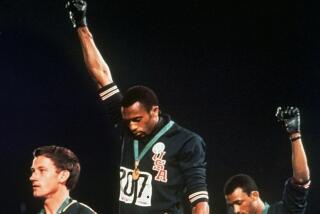Milky White Substance: Is It a Solution?
- Share via
TORONTO — Unless Dr. Jamie Astaphan comes forward with a diary of his own, the mystery of Ben Johnson’s positive drug test for the anabolic steroid, stanozolol, in the 1988 Olympic Games might never be solved.
But the most plausible explanation to date emerged Thursday when sprinter Angella Taylor Issajenko suggested that Astaphan gave her, Johnson and other Canadian athletes stanozolol under false pretenses.
On her fourth and final day of testimony before the Canadian government’s commission of inquiry into drug use by athletes, Issajenko said that Astaphan gave the athletes unmarked bottles of a milky white substance, which he identified as Estragol.
But she said that she believes the substance could have been a veterinary preparation called Winstrol-V, the brand name for stanozolol. Winstrol-V also is milky white.
That would explain Johnson’s positive test for stanozolol after he had won the 100 meters Sept. 24 in Seoul, 22 days after his last injection of the drug that he, according to testimony from Issajenko, referred to simply as “Astaphan’s white stuff.”
That also explains the 20-second pause after Issajenko was asked Wednesday by the doctor’s attorney, David Sookram, whether she trusted Astaphan, who had treated Johnson, Issajenko and other athletes coached by Charlie Francis from 1984 through the 1988 Games.
After receiving no response, Sookram changed the question to whether Issajenko liked Astaphan.
“I do like him,” she said. “I have no bad feelings against him.”
But Thursday, under questioning by the commission’s chairman, Ontario associate chief justice Charles L. Dubin, Issajenko said that she had doubts about the substance that Astaphan first gave her in 1986 because it had the same side effects as Winstrol, which she had used in the oral form for a brief time in 1982.
After discussing it with two other Canadian athletes she said were using the drug, sprinter Desai Williams and hurdler Mark McKoy, she testified that they came to the conclusion that the substance “probably was Winstrol V. But nobody was sure.”
The attorney who represented Astaphan Thursday, Lorne Levine, was angry afterward, complaining that he had no advance warning of Issajenko’s testimony.
Asked if it were possible that Astaphan had given the athletes Winstrol-V, he said: “I’m not about to comment on that. I think he’ll testify that there was informed consent, that the patients were aware of what they were receiving.”
Astaphan, who lives on the Caribbean island of St. Kitts, is scheduled to testify in May.
Before announcing an adjournment until April 3, Dubin instructed the commission to draw no conclusions until all the testimony is heard.
One thing that is increasingly clear, however, is that the drug Astaphan gave the athletes was not Estragol, a brand name that is not listed in any of the standard physicians’ reference books. Issajenko said that Astaphan, once the inquiry was called, told her the drug in question was Miotolin, a brand name for the steroid furazabol.
Issajenko, who kept the drugs that the athletes used at her Toronto home, said that she gave 12 bottles of the substance to the commission. Sources close to the commission told The Times that the substance was analyzed at a laboratory, but they would not reveal whether it contained stanozolol.
During Francis’ testimony earlier this month, the commission’s co-counsel, Robert P. Armstrong, repeatedly questioned him about the Estragol “or the substance you believed to be Estragol.”
But although Francis testified that Johnson had been using steroids and other performance enhancing drugs banned by the International Olympic Committee since 1981, the coach said that it would have been obvious to him if the sprinter was on stanozolol before the Summer Olympics.
He said that the sprinter used the oral form of the drug, Winstrol, several times between 1982 and the spring of 1987 and invariably complained of soreness. He said that Johnson had no such complaints during his last cycle of drug use--Aug 22-Sept. 2--before leaving for Seoul.
Francis presented a sabotage scenario, pointing a finger at an unidentified stranger in the doping control area after the race who, he said, could have spiked Johnson’s drink with stanozolol. Issajenko said that Francis also cast suspicion on the Canadian track and field team’s physical therapist, Waldemar Matuszewski, who could have rubbed stanozolol into Johnson’s system during a massage. Although Issajenko said earlier this week she initially believed Matuszewski was a possible saboteur, she ultimately concluded that Astaphan and Johnson “cut it too close.”
According to testimony from both Francis and Issajenko, Astaphan usually instructed the athletes to stop using drugs at least 28 days before testing. There were only 22 days between Johnson’s last injection of the so-called Estragol and the 100 meter final in Seoul.
More to Read
Go beyond the scoreboard
Get the latest on L.A.'s teams in the daily Sports Report newsletter.
You may occasionally receive promotional content from the Los Angeles Times.






